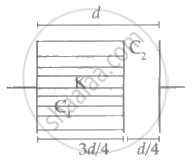Advertisements
Advertisements
प्रश्न
For changing the capacitance of a given parallel plate capacitor, a dielectric material of dielectric constant K is used, which has the same area as the plates of the capacitor.
The thickness of the dielectric slab is `3/4`d, where 'd' is the separation between the plate of the parallel plate capacitor.
The new capacitance (C') in terms of the original capacitance (C0) is given by the following relation:
विकल्प
C' = `(4"K")/("K"+3)"C"_0`
C' = `4/(3+"K")"C"_0`
C' = `(3+"K")/(4"K")"C"_0`
C' = `(4+"K")/4"C"_0`
उत्तर
`bb("C"^' = (4"K")/("K"+3)"C"_0)`
Explanation:
The expression of a parallel place capacitor

Here, `"C"_0 = ("A"epsilon_0)/"d"`
So, `"C"_1 = ("KA"epsilon_0)/((3"d")/4)` .....at d →`(3"d")/4`
And `"C"_2 = ("A"epsilon_0)/("d"/4)` ....at d →`"d"/4`
Now equivalent capacitance
C' = `("C"_1"C"_2)/("C"_1+"C"_2)`
⇒ `((4"K"("A"epsilon_0)/(3"d"))(4("A"epsilon_0)/"d"))/(4"K"("A"epsilon_0)/(3"d")+4("A"epsilon_0)/"d")`
⇒ `((4"KA"^2epsilon_0^2)/(3"d"^2)xx4)/((4"A"epsilon_0)/"d"["K"/3+1])`
⇒ `(4"K")/((3+"K"))"C"_0`
